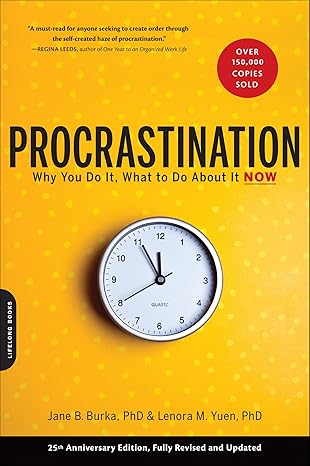
The Law of Success
Originally published in 1928, this is the book that began Napoleon Hill's self-help odyssey. Hill queried dozens of people about the keys to their prosperity and organized his findings into 16 principles. Each principle marks a chapter of this book, forming a methodology for employing untapped 'mind-power' that leads to success. Hill was well known for researching what made millionaires different from the common man. The sixteen lessons in this book perfectly crystallize everything you will need to know to succeed during these hard economic times. Many of today's best known self-help books take their core concepts form this book. 'The Secret', 'The Power of Positive Thinking', 'The Millionaire Next Door', and 'The Law of Attraction' all take their basic premises from this landmark work. Once you've read this book you will understand what gives certain people an edge over everyone else. By following the advice laid out clearly herein you'll be the one with an edge. It's time to stop wondering what it's like to be rich and start knowing. This book has changed countless lives and it can change yours! Unlike many of the other editions on the market today, this edition is complete and unabridged!!
BEST DEALS
About the Author
Napoleon Hill was an American author in the area of the new thought movement who was one of the earliest producers of the modern genre of personal-success literature. He is widely considered to be one of the great writers on success. His teachings have gone on to influence entire generations of success seekers, setting the standard for the foundations of today's motivational thinking. His most famous work—'Think and Grow Rich' (1937), is one of the best-selling books of all time (at the time of Hill's death in 1970, Think and Grow Rich had sold 20 million copies). Hill's works examined the power of personal beliefs, and the role they play in personal success. He became an advisor to President Franklin D. Roosevelt from 1933 to 1936. "What the mind of man can conceive and believe, it can achieve" is one of Hill's hallmark expressions. How achievement actually occurs, and a formula for it that puts success in reach of the average person, were the focal points of Hill's books.
Read Sample
Lesson One : The Master Mind
“You Can Do It if You Believe You Can!”
This is a course on the fundamentals of Success.
Success is very largely a matter of adjusting one’s self to the ever-varying and changing environments of life, in a spirit of harmony and poise. Harmony is based upon understanding of the forces constituting one’s environment; therefore, this course is in reality a blueprint that may be followed straight to success, because it helps the student to interpret, understand and make the most of these environmental forces of life.
Before you begin reading the Law of Success lessons you should know something of the history of the course. You should know exactly what the course promises to those who follow it until they have assimilated the laws and principles upon which it is based. You should know its limitations as well as its possibilities as an aid in your fight for a place in the world.
From the viewpoint of entertainment the Law of Success course would be a poor second for most any of the monthly periodicals of the “Snappy Story” variety which may be found upon the news stands of today.
The course has been created for the serious-minded person who devotes at least a portion of his or her time to the business of succeeding in life. The author of the Law of Success course has not intended to compete with those who write purely for the purpose of entertaining.
The author’s aim, in preparing this course, has been of a two-fold nature, namely, first-to help the earnest student find out what are his or her weaknesses, and, secondly-to help create a DEFINITE PLAN for bridging those weaknesses.
The most successful men and women on earth have had to correct certain weak spots in their personalities before they began to succeed. The most outstanding of these weaknesses which stand between men and women and success are INTOLERANCE, CUPIDITY, GREED, JEALOUSY, SUSPICION, REVENGE, EGOTISM, CONCEIT, THE TENDENCY TO REAP WHERE THEY HAVE NOT SOWN, and the HABIT OF SPENDING MORE THAN THEY EARN.
All of these common enemies of mankind, and many more not here mentioned, are covered by the Law of Success course in such a manner that any person of reasonable intelligence may master them with but little effort or inconvenience.
You should know, at the very outset, that the Law of Success course has long since passed through the experimental state; that it already has to its credit a record of achievement that is worthy of serious thought and analysis. You should know, also, that the Law of Success course has been examined and endorsed by some of the most practical minds of this generation.
The Law of Success course was first used as a lecture, and was delivered by its author in practically every city and in many of the smaller localities, throughout the United States, over a period of more than seven years. Perhaps you were one of the many hundreds of thousands of people who heard this lecture.
During these lectures the author had assistants located in the audiences for the purpose of interpreting the reaction of those who heard the lecture, and in this manner he learned exactly what effect it had upon people. As a result of this study and analysis many changes were made.
The first big victory was gained for the Law of Success philosophy when it was used by the author as the basis of a course with which 3,000 men and women were trained as a sales army. The majority of these people were without previous experience, of any sort, in the field of selling. Through this training they were enabled to earn more than One Million Dollars ($1,000,000.00) for themselves and paid the author $30,000.00 for his services, covering a period of approximately six months.
The individuals and small groups of salespeople who have found success through the aid of this course are too numerous to be mentioned in this Introduction, but the number is large and the benefits they derived from the course were definite.
The Law of Success philosophy was brought to the attention of the late Don R. Mellett, former publisher of the Canton (Ohio) Daily News, who formed a partnership with the author of the course and was preparing to resign as publisher of the Canton Daily News and take up the business management of the author’s affairs when he was assassinated on July 16, 1926.
Prior to his death Mr. Mellett had made arrangements with judge Elbert H. Gary, who was then Chairman of the Board of the United States Steel Corporation, to present the Law of Success course to every employee of the Steel Corporation, at a total cost of something like $150,000.00. This plan was halted because of judge Gary’s death, but it proves that the author of the Law of Success has produced an educational plan of an enduring nature. Judge Gary was eminently prepared to judge the value of such a course, and the fact that he analyzed the Law of Success philosophy and was preparing to invest the huge sum of $150,000.00 in it is proof of the soundness of all that is said in behalf of the course.
You will observe, in this General Introduction to the course, a few technical terms which may not be plain to you. Do not allow this to bother you. Make no attempt at first reading to understand these terms. They will be plain to you after you read the remainder of the course. This entire Introduction is intended only as a background for the other fifteen lessons of the course, and you should read it as such. You will not be examined on this Introduction, but you should read it many times, as you will get from it at each reading a thought or an idea which you did not get on previous readings.
In this Introduction you will find a description of a newly discovered law of psychology which is the very foundation stone of all outstanding personal achievements. This law has been referred to by the author as the “Master Mind,” meaning a mind that is developed through the harmonious co-operation of two or more people who ally themselves for the purpose of accomplishing any given task.
If you are engaged in the business of selling you may profitably experiment with this law of the “Master Mind” in your daily work. It has been found that a group of six or seven salespeople may use the law so effectively that their sales may be increased to unbelievable proportions.
Life Insurance is supposed to be the hardest thing on earth to sell. This ought not to be true, with an established necessity such as life insurance, but it is. Despite this fact, a small group of men working for the Prudential Life Insurance Company, whose sales are mostly small policies, formed a little friendly group for the purpose of experimenting with the law of the “Master Mind,” with the result that every man in the group wrote more insurance during the first three months of the experiment than he had ever written in an entire year before.
What may be accomplished through the aid of this principle, by any small group of intelligent life-insurance salesmen who have learned how to apply the law of the “Master Mind” will stagger the imagination of the most highly optimistic and imaginative person.
The same may be said of other groups of salespeople who are engaged in selling merchandise and other more tangible forms of service than life insurance. Bear this in mind as you read this Introduction to the Law of Success course and it is not unreasonable to expect that this Introduction, alone, may give you sufficient understanding of the law to change the entire course of your life.
No man has a chance to enjoy permanent success until he begins to look in a mirror for the real cause of all his mistakes.
Napoleon Hill
It is the personalities back of a business which determine the measure of success the business will enjoy. Modify those personalities so they are more pleasing and more attractive to the patrons of the business and the business will thrive. In any of the great cities of the United States one may purchase merchandise of similar nature and price in scores of stores, yet you will find there is always one outstanding store which does more business than any of the others, and the reason for this is that back of that store is a man, or men, who has attended to the personalities of those who come in contact with the public. People buy personalities as much as merchandise, and it is a question if they are not influenced more by the personalities with which they come in contact than they are by the merchandise.
Life insurance has been reduced to such a scientific basis that the cost of insurance does not vary to any great extent, regardless of the company from which one purchases it, yet out of the hundreds of life insurance companies doing business less than a dozen companies do the bulk of the business of the United States.
Why? Personalities! Ninety-nine people out of every hundred who purchase life insurance policies do not know what is in their policies and, what seems more startling, do not seem to care. What they really purchase is the pleasing personality of some man or woman who knows the value of cultivating such a personality.
Your business in life, or at least the most important part of it, is to achieve success. Success, within the meaning of that term as covered by this course on the Fifteen Laws of Success, is “the attainment of your Definite Chief Aim without violating the rights of other people.” Regardless of what your major aim in life may be, you will attain it with much less difficulty after you learn how to cultivate a pleasing personality and after you have learned the delicate art of allying yourself with others in a given undertaking without friction or envy.
One of the greatest problems of life, if not, in fact, the greatest, is that of learning the art of harmonious negotiation with others. This course was created for the purpose of teaching people how to negotiate their way through life with harmony and poise, free from the destructive effects of disagreement and friction which bring millions of people to misery, want and failure every year.
With this statement of the purpose of the course you should be able to approach the lessons with the feeling that a complete transformation is about to take place in your personality.
You cannot enjoy outstanding success in life without power, and you can never enjoy power without sufficient personality to influence other people to cooperate with you in a spirit of harmony. This course shows you step by step how to develop such a personality.
Lesson by lesson, the following is a statement of that which you may expect to receive from the Fifteen Laws of Success:
I. A DEFINITE CHIEF AIM will teach you how to save the wasted effort which the majority of people expend in trying to find their lifework. This lesson will show you how to do away forever with aimlessness and fix your heart and hand upon some definite, well conceived purpose as a life-work.
II. SELF-CONFIDENCE will help you master the six basic fears with which every person is cursed-the fear of Poverty, the fear of Ill Health, the fear of Old Age, the fear of Criticism, the fear of Loss of Love of Someone and the fear of Death. It will teach you the difference between egotism and real self-confidence which is based upon definite, usable knowledge.
III. HABIT OF SAVING will teach you how to distribute your income systematically so that a definite percentage of it will steadily accumulate, thus forming one of the greatest known sources of personal power. No one may succeed in life without saving money. There is no exception to this rule, and no one may escape it.
IV. INITIATIVE AND LEADERSHIP will show you how to become a leader instead of a follower in your chosen field of endeavor. It will develop in you the instinct for leadership which will cause you gradually to gravitate to the top in all undertakings in which you participate.
V. IMAGINATION will stimulate your mind so that you will conceive new ideas and develop new plans which will help you in attaining the object of your Definite Chief Aim. This lesson will teach you how to “build new houses out of old stones,” so to speak. It will show you how to create new ideas out of old, well known concepts, and how to put old ideas to new uses. This one lesson, alone, is the equivalent of a very practical course in salesmanship, and it is sure to prove a veritable gold mine of knowledge to the person who is in earnest.
VI. ENTHUSIASM will enable you to “saturate” all with whom you come in contact with interest in you and in your ideas. Enthusiasm is the foundation of a Pleasing Personality, and you must have such a personality in order to influence others to co-operate with you.
VII. SELF-CONTROL is the “balance wheel” with which you control your enthusiasm and direct it where you wish it to carry you. This lesson will teach you, in a most practical manner, to become “the master of your fate, the Captain of your Soul.”
VIII. THE HABIT OF DOING MORE THAN PAID FOR is one of the most important lessons of the Law of Success course. It will teach you how to take advantage of the Law of Increasing Returns, which will eventually insure you a return in money far out of proportion to the service you render. No one may become a real leader in any walk of life without practicing the habit of doing more work and better work than that for which he is paid.
IX. PLEASING PERSONALITY is the “fulcrum” on which you must place the “crow-bar” of your efforts, and when so placed, with intelligence, it will enable you to remove mountains of obstacles. This one lesson, alone, has made scores of Master Salesmen. It has developed leaders over night. It will teach you how to transform your personality so that you may adapt yourself to any environment, or to any other personality, in such a manner that you may easily dominate.
X. ACCURATE THINKING is one of the important foundation stones of all enduring success. This lesson teaches you how to separate “facts” from mere “information.” It teaches you how to organize known facts into two classes: the “important” and the “unimportant.” It teaches you how to determine what is an “important” fact. It teaches you how to build definite working plans, in the pursuit of any calling, out of FACTS.
XI. CONCENTRATION teaches you how to focus your attention upon one subject at a time until you have worked out practical plans for mastering that subject. It will teach you how to ally yourself with others in such a manner that you may have the use of their entire knowledge to back you up in your own plans and purposes. It will give you a practical working knowledge of the forces around you, and show you how to harness and use these forces in furthering your own interests.
XII. CO-OPERATION will teach you the value of team-work in all you do. In this lesson you will be taught how to apply the law of the “Master Mind” described in this Introduction and in Lesson Two of this course. This lesson will show you how to co-ordinate your own efforts with those of others, in such a manner that friction, jealousy, strife, envy and cupidity will be eliminated. You will learn how to make use of all that other people have learned about the work in which you are engaged.
XIII. PROFITING BY FAILURE will teach you how to make stepping stones out of all of your past and future mistakes and failures. It will teach you the difference between “failure” and “temporary defeat,” a difference which is very great and very important. It will teach you how to profit by your own failures and by the failures of other people.
XIV. TOLERANCE will teach you how to avoid the disastrous effects of racial and religious prejudices which mean defeat for millions of people who permit themselves to become entangled in foolish argument over these subjects, thereby poisoning their own minds and closing the door to reason and investigation. This lesson is the twin sister of the one on ACCURATE THOUGHT, for the reason that no one may become an Accurate Thinker without practicing tolerance. Intolerance closes the book of Knowledge and writes on the cover, “Finis! I have learned it all!” Intolerance makes enemies of those who should be friends. It destroys opportunity and fills the mind with doubt, mistrust and prejudice.
XV. PRACTICING THE GOLDEN RULE will teach you how to make use of this great universal law of human conduct in such a manner that you may easily get harmonious co-operation from any individual or group of individuals. Lack of understanding of the law upon which the Golden Rule philosophy is based is one of the major causes of failure of millions of people who remain in misery, poverty and want all their lives. This lesson has nothing whatsoever to do with religion in any form, nor with sectarianism, nor have any of the other lessons of this course on the Law of Success.
If you must slander someone don’t speak it—but write it—write it in the sand, near the water’s edge!
Napoleon Hill
When you have mastered these Fifteen Laws and made them your own, as you may do within a period of from fifteen to thirty weeks, you will be ready to develop sufficient personal power to insure the attainment of your Definite Chief Aim.
The purpose of these Fifteen Laws is to develop or help you organize all the knowledge you have, and all you acquire in the future, so you may turn this knowledge into POWER.
You should read the Law of Success course with a note-book by your side, for you will observe that ideas will begin to “flash” into your mind as you read, as to ways and means of using these laws in advancing your own interests.
You should also begin teaching these laws to those in whom you are most interested, as it is a well known fact that the more one tries to teach a subject the more he learns about that subject. A man who has a family of young boys and girls may so indelibly fix these Fifteen Laws of Success in their minds that this teaching will change the entire course of their lives. The man with a family should interest his wife in studying this course with him, for reasons which will be plain before you complete reading this Introduction.
POWER is one of the three basic objects of human endeavor.
POWER is of two classes-that which is developed through co-ordination of natural physical laws, and that which is developed by organizing and classifying KNOWLEDGE.
POWER growing out of organized knowledge is the more important because it places in man’s possession a tool with which he may transform, redirect and to some extent harness and use the other form of power.
The object of this reading course is to mark the route by which the student may safely travel in gathering such facts as he may wish to weave into his fabric of KNOWLEDGE.
There are two major methods of gathering knowledge, namely, by studying, classifying and assimilating facts which have been organized by other people, and through one’s own process of gathering, organizing and classifying facts, generally called “personal experience.”
This lesson deals mainly with the ways and means of studying the facts and data gathered and classified by other people.
* * *
The state of advancement known as “civilization” is but the measure of knowledge which the race has accumulated. This knowledge is of two classes—mental and physical.
Among the useful knowledge organized by man, he has discovered and catalogued the eighty-odd physical elements of which all material forms in the universe consist.
By study and analysis and accurate measurements man has discovered the “bigness” of the material side of the universe as represented by planets, suns and stars, some of which are known to be over ten million times as large as the little earth on which he lives.
On the other hand, man has discovered the “littleness” of the physical forms which constitute the universe by reducing the eighty-odd physical elements to molecules, atoms, and, finally, to the smallest particle, the electron. An electron cannot be seen; it is but a center of force consisting of a positive or a negative. The electron is the beginning of everything of a physical nature.
MOLECULES, ATOMS AND ELECTRONS: To understand both the detail and the perspective of the process through which knowledge is gathered, organized and classified, it seems essential for the student to begin with the smallest and simplest particles of physical matter, because these are the A B C’s with which Nature has constructed the entire frame-work of the physical portion of the universe.
The molecule consists of atoms, which are said to be little invisible particles of matter revolving continuously with the speed of lightning, on exactly the same principle that the earth revolves around the sun.
These little particles of matter known as atoms, which revolve in one continuous circuit, in the molecule, are said to be made up of electrons, the smallest particles of physical matter. As already stated, the electron is nothing but two forms of force. The electron is uniform, of but one class, size and nature; thus in a grain of sand or a drop of water the entire principle upon which the whole universe operates is duplicated.
How marvelous! How stupendous! You may gather some slight idea of the magnitude of it all the next time you eat a meal, by remembering that every article of food you eat, the plate on which you eat it, the tableware and the table itself are, in final analysis, but a collection of ELECTRONS.
In the world of physical matter, whether one is looking at the largest star that floats through the heavens or the smallest grain of sand to be found on earth, the object under observation is but an organized collection of molecules, atoms and electrons revolving around one another at inconceivable speed.
Every particle of physical matter is in a continuous state of highly agitated motion. Nothing is ever still, although nearly all physical matter may appear, to the physical eye, to be motionless. There is no “solid” physical matter. The hardest piece of steel is but an organized mass of revolving molecules, atoms and electrons. Moreover, the electrons in a piece of steel are of the same nature, and move at the same rate of speed as the electrons in gold, silver, brass or pewter.
The eighty-odd forms of physical matter appear to be different from one another, and they are different, because they are made up of different combinations of atoms (although the electrons in these atoms are always the same, except that some electrons are positive and some are negative, meaning that some carry a positive charge of electrification while others carry a negative charge).
Don’t be afraid of a little opposition. Remember that the “Kite” of Success generally rises AGAINST the wind of Adversity—not with it!
Through the science of chemistry, matter may be broken up into atoms which are, within themselves, unchangeable. The eighty-odd elements are created through and by reason of combining and changing of the positions of the atoms. To illustrate the modus operandi of chemistry through which this change of atomic position is wrought, in terms of modern science:
“Add four electrons (two positive and two negative) to the hydrogen atom, and you have the element lithium; knock out of the lithium atom (composed of three positive and three negative electrons) one positive and one negative electron, and you have one atom of helium (composed of two positive and two negative electrons)
Thus it may be seen that the eighty-odd physical elements of the universe differ from one another only in the number of electrons composing their atoms, and the number and arrangement of those atoms in the molecules of each element.
As an illustration, an atom of mercury contains eighty positive charges (electrons) in its nucleus, and eighty negative outlying charges (electrons). If the chemist were to expel two of its positive electrons it would instantly become the metal known as platinum. If the chemist could then go a step further and take from it a negative (“planetary”) electron, the mercury atom would then have lost two positive electrons and one negative; that is, one positive charge on the whole; hence it would retain seventy-nine positive charges in the nucleus and seventy-nine outlying negative electrons, thereby becoming GOLD!
The formula through which this electronic change might be produced has been the object of diligent search by the alchemists all down the ages, and by the modern chemists of today.
It is a fact known to every chemist that literally tens of thousands of synthetic substances may be composed out of only four kinds of atoms, viz.: hydrogen, oxygen, nitrogen and carbon.
“Differences in the number of electrons in atoms confer upon them qualitative (chemical) differences, though all atoms of any one element are chemically alike. Differences in the number and special arrangement of these atoms (in groups of molecules) constitute both physical and chemical differences in substances, i.e., in compounds. Quite different substances are produced by combinations of precisely the same kinds of atoms, but in different proportions.
“Take from a molecule of certain substances one single atom, and they may be changed from a compound necessary to life and growth into a deadly poison. Phosphorus is an element, and thus contains but one kind of atoms; but some phosphorus is yellow and some is red, varying with the special distribution of the atoms in the molecules composing the phosphorus.”
It may be stated as a literal truth that the atom is the universal particle with which Nature builds all material forms, from a grain of sand to the largest star that floats through space. The atom is Nature’s “building block” out of which she erects an oak tree or a pine, a rock of sandstone or granite, a mouse or an elephant.
Some of the ablest thinkers have reasoned that the earth on which we live, and every material particle on the earth, began with two atoms which attached themselves to each other, and through hundreds of millions of years of flight through space, kept contacting and accumulating other atoms until, step by step, the earth was formed. This, they point out, would account for the various and differing strata of the earth’s substances, such as the coal beds, the iron ore deposits, the gold and silver deposits, the copper deposits, etc.
They reason that, as the earth whirled through space, it contacted groups of various kinds of nebulae, or atoms, which it promptly appropriated, through the law of magnetic attraction. There is much to be seen, in the earth’s surface composition, to support this theory, although there may be no positive evidence of its soundness.
These facts concerning the smallest analyzable particles of matter have been briefly referred to as a starting point from which we shall undertake to ascertain how to develop and apply the law of POWER.
It has been noticed that all matter is in a constant state of vibration or motion; that the molecule is made up of rapidly moving particles called atoms, which, in turn, are made up of rapidly moving particles called electrons.
THE VIBRATING FLUID OF MATTER: In every particle of matter there is an invisible “fluid” or force which causes the atoms to circle around one another at an inconceivable rate of speed.
This “fluid” is a form of energy which has never been analyzed. Thus far it has baffled the entire scientific world. By many scientists it is believed to be the same energy as that which we call electricity. Others prefer to call it vibration. It is believed by some investigators that the rate of speed with which this force (call it whatever you will) moves determines to a large extent the nature of the outward visible appearance of the physical objects of the universe.
One rate of vibration of this “fluid energy” causes what is known as sound. The human ear can detect only the sound which is produced through from 32,000 to 38,000 vibrations per second.












